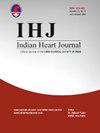Leveraging ECG images for predicting ejection fraction using machine learning algorithms
IF 1.8
Q3 CARDIAC & CARDIOVASCULAR SYSTEMS
引用次数: 0
Abstract
Introduction
The capability to accurately predict the ejection fraction (EF) from an electrocardiogram (ECG) holds significant and valuable clinical implications. Various algorithms based on ECG images are currently being evaluated, with most methods requiring raw signal data from ECG devices. In this study, our objective was to train and validate a neural network on a readily available ECG trace image graph to determine the presence or absence of left ventricular dysfunction (LVD).
Methods
12-lead ECG trace images paired with their echocardiogram reports performed on the same day were selected. A DenseNet121 model, using ECG images as input, was trained to identify EF <50 %. and then externally validated.
Results
1,19,281 ECG-echocardiogram pairs were used for model development. The model demonstrated comparable performance in both the internal test data and external validation data. The area under receiver operating characteristic and precision–recall curves were 0.92 and 0.78, respectively, for the internal test data and 0.88 and 0.74, respectively, for the external validation data. The model accurately identified more than 85 % of cases with EF <50 % in both datasets.
Conclusions
Actual images of ECGs with simple pre-processing and model architecture can be used as a reliable tool to screen for LVD. The use of images expands the reach of these algorithms to geographies with resource and technological limitations.
利用ECG图像预测射血分数使用机器学习算法。
从心电图(ECG)准确预测射血分数(EF)的能力具有重要和有价值的临床意义。目前正在评估各种基于心电图像的算法,大多数方法需要来自心电设备的原始信号数据。在这项研究中,我们的目标是训练和验证一个神经网络在一个现成的ECG跟踪图像图上,以确定左心室功能障碍(LVD)的存在与否。方法:选择12导联心电示踪图像与当日超声心动图报告配对。使用心电图图像作为输入,DenseNet121模型被训练以识别EF。结果:1,19,281对心电图超声心动图用于模型开发。该模型在内部测试数据和外部验证数据中均表现出相当的性能。内部试验数据的受试者工作特征曲线下面积为0.92,精密度召回曲线下面积为0.78,外部验证数据的受试者工作特征曲线下面积为0.88,精密度召回曲线下面积为0.74。结论:经简单预处理和模型构建的实际心电图图像可作为筛选LVD的可靠工具。图像的使用将这些算法扩展到具有资源和技术限制的地理位置。
本文章由计算机程序翻译,如有差异,请以英文原文为准。
求助全文
约1分钟内获得全文
求助全文
来源期刊

Indian heart journal
CARDIAC & CARDIOVASCULAR SYSTEMS-
CiteScore
2.60
自引率
6.70%
发文量
82
审稿时长
52 days
期刊介绍:
Indian Heart Journal (IHJ) is the official peer-reviewed open access journal of Cardiological Society of India and accepts articles for publication from across the globe. The journal aims to promote high quality research and serve as a platform for dissemination of scientific information in cardiology with particular focus on South Asia. The journal aims to publish cutting edge research in the field of clinical as well as non-clinical cardiology - including cardiovascular medicine and surgery. Some of the topics covered are Heart Failure, Coronary Artery Disease, Hypertension, Interventional Cardiology, Cardiac Surgery, Valvular Heart Disease, Pulmonary Hypertension and Infective Endocarditis. IHJ open access invites original research articles, research briefs, perspective, case reports, case vignette, cardiovascular images, cardiovascular graphics, research letters, correspondence, reader forum, and interesting photographs, for publication. IHJ open access also publishes theme-based special issues and abstracts of papers presented at the annual conference of the Cardiological Society of India.
 求助内容:
求助内容: 应助结果提醒方式:
应助结果提醒方式:


